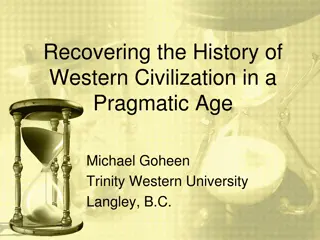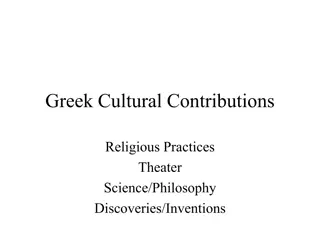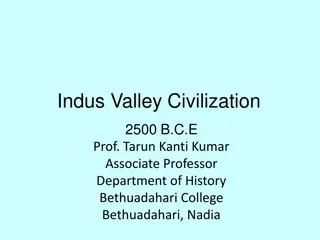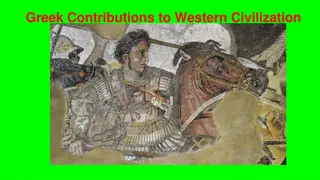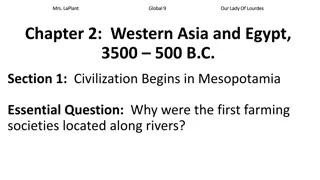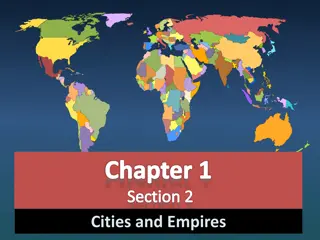Civilization History Overview
The concept of civilization, its development, and key elements including surplus food production, social stratification, governments, writing, and cultural evolution. Explore the origins and complexity of societies throughout history.
Download Presentation

Please find below an Image/Link to download the presentation.
The content on the website is provided AS IS for your information and personal use only. It may not be sold, licensed, or shared on other websites without obtaining consent from the author.If you encounter any issues during the download, it is possible that the publisher has removed the file from their server.
You are allowed to download the files provided on this website for personal or commercial use, subject to the condition that they are used lawfully. All files are the property of their respective owners.
The content on the website is provided AS IS for your information and personal use only. It may not be sold, licensed, or shared on other websites without obtaining consent from the author.
E N D
Presentation Transcript
TIU Tishk International University FASE IRD Department Civilization History Civilization History Code: IRD 116 UNIT I : INTRODUCTION COURSE EDUCATOR Associated Professor Dr. NEVILLE D Cunha
Civilization History (1) Introduction The term civilization refers to complex societies, but the specific definition is contested. The advent of civilization depended on the ability of some agricultural settlements to consistently produce surplus food, which allowed some people to specialize in non- agricultural work, which in turn allowed for increased production, trade, population, and social stratification. The first civilizations appeared in locations where the geography was favorable to intensive agriculture.
Civilization History (2) Introduction Governments and states emerged as rulers gained control over larger areas and more resources, often using writing and religion to maintain social hierarchies and consolidate power over larger areas and populations. Writing allowed for the codification of laws, better methods of record-keeping, and the birth of literature, which fostered the spread of shared cultural practices among larger populations.
Civilization History (3) Degrees of complexity Today, almost every city has a supermarket with a wide variety of available foods. We take for granted the fact that people have different types of jobs and that governments exist. But, reliable food sources, specialized work, and governments did not exist for most of human history! They are the products of historical processes that began with the first civilizations several thousand years ago.
Civilization History (4) Degrees of complexity A civilization is a complex society that creates agricultural surpluses, allowing for specialized labor, social hierarchy, and the establishment of cities. Developments such as writing, complex religious systems, monumental architecture, and centralized political power have been suggested as identifying markers of civilization, as well. When we see these changes occur, we should stop and ask, Did people institute these practices because they were beneficial, or were they forced on them? Historians debate this very question, trying to determine whether civilization was a bottom-up or top-down development. Most likely, it was a bit of both.
Civilization History (5) Degrees of complexity Some people think civilization is an advanced stage in the progression of human cultural evolution. But, when historians or anthropologists use the term civilization, they mean a society has many different, interconnected parts. So, rather than thinking about different forms of social organization as completely separate models, it s helpful to think in terms of a spectrum of complexity. On one end, we have hunter-forager societies which have little complexity and on the other end, we have civilizations which are highly complex. In between lie a wide variety of social structures of varying types and levels of complexity.
Civilization History (6) Degrees of complexity On one end, we have hunter-forager societies which have little complexity and on the other end, we have civilizations which are highly complex. In between lie a wide variety of social structures of varying types and levels of complexity.
Civilization History (7) First civilizations The first civilizations appeared in major river valleys, where floodplains contained rich soil and the rivers provided irrigation for crops and a means of transportation. Foundational civilizations developed urbanization and complexity without outside influence and without building on a pre-existing civilization, though they did not all develop simultaneously. Many later civilizations either borrowed elements of, built on, or incorporated through conquest other civilizations. Because foundational civilizations arose independently, they are particularly useful to historians and archaeologists who want to understand how civilization first developed.
Civilization History (8) Foundational civilizations: Developed urbanization and complexity without outside influence and without building on a pre- existing civilization, though they did not all develop simultaneously. Many later civilizations either borrowed elements of, built on, or incorporated through conquest other civilizations. Because foundational civilizations arose independently, they are particularly useful to historians and archaeologists who want to understand how civilization first developed.
Civilization History (9:2) Map showing probable areas of independent development of agriculture, in green, and possible routes of diffusion. Note that while there is much overlap between these regions and the locations of first civilizations, some areas like the Indus Valley in northwest India appear to have developed agriculture after the practice spread to the region.
Civilization History (10) What do civilizations have in common? Cities were at the center of all early civilizations. People from surrounding areas came to cities to live, work, and trade. This meant that large populations of individuals who did not know each other lived and interacted with one another. So, shared institutions, such as government, religion, and language helped create a sense of unity and also led to more specialized roles, such as bureaucrats, priests, and scribes.
Civilization History (11) What do civilizations have in common? Cities concentrated political, religious, and social institutions that were previously spread across many smaller, separate communities, which contributed to the development of states. A state is an organized community that lives under a single political structure. A present-day country is a state in this sense, for example. Many civilizations either grew alongside a state or included several states. The political structures that states provided were an important factor in the rise of civilizations because they made it possible to mobilize large amounts of resources and labor and also tied larger communities together by connecting them under a common political system.
Civilization History (12) What do civilizations have in common? Early civilizations were often unified by religion a system of beliefs and behaviors that deal with the meaning of existence. As more and more people shared the same set of beliefs and practices, people who did not know each other could find common ground and build mutual trust and respect.
Civilization History (13) What do civilizations have in common? Both political and religious organization helped to create and reinforce social hierarchies, which are clear distinctions in status between individual people and between different groups. Political leaders could make decisions that impacted entire societies, such as whether to go to war. Religious leaders gained special status since they alone could communicate between a society and its god or gods.
Civilization History (14) What do civilizations have in common? Writing emerged in many early civilizations as a way to keep records and better manage complex institutions. Cuneiform writing in early Mesopotamia was first used to keep track of economic exchanges.
Civilization History (14) What do civilizations have in common? Another notable feature of many civilizations was monumental architecture. This type of architecture was often created for political reasons, religious purposes, or for the public good.
Civilization History (15) What do civilizations have in common? Writing offered new methods for maintaining law and order, as well. The first legal codes, or written collections of laws, were the Code of Ur-Nammu from Sumer, written around 2100 to 2050 BCE and the Code of Hammurabi from Babylon, written around 1760 BCE. The benefit of written laws was that they created consistency in the legal system.
Civilization History (16) What do civilizations have in common? There were many features that early civilizations had in common. Most civilizations developed from agrarian communities that provided enough food to support cities. Cities intensified social hierarchies based on gender, wealth, and division of labor. Some developed powerful states and armies, which could only be maintained through taxes.
Civilization History (17) What do civilizations have in common? Is it writing? A quipu was a system of knotted strings that could be used to perform calculations and to record transactions. Evidence for the use of quipu has been found in many Andean cultures over the past several millennia. .
Civilization History (18) What do civilizations have in common? Law Code of Hammurabi inscribed on basalt stele. If you look closely, you can make out the cuneiform writing in the center.
Civilization History (19) What do civilizations have in common? What do you think? When does a complex society become a civilization? What factors were most important to establishing and maintaining a civilization? Do you think that social hierarchies are necessary for civilization? Are state-level political structures necessary for civilization? Or, can independent cities with a shared culture be a civilization?




